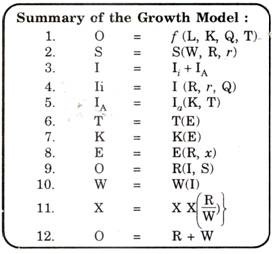The following points highlight the twelve propositions of Schumpeter’s model of economic growth.
Proposition 1:
Production Function:
The production function is same as in the classical economy i.e.
O = ƒ (L, K, Q, T)
ADVERTISEMENTS:
L = Labour force
K = Capital stock
T = Technology
Proposition 2:
Saving depends on wages, Profits and Interest Rates:
ADVERTISEMENTS:
Savings depend upon wages, profits and interest rate. Workers and capitalist do savings of their incomes and their savings increase as their income rises. Schumpeter retained the neo-classical proposition that saving tends to rise with increase in interest rate i.e.
S = S (W, R, r)
S = Saving
W = Wages
ADVERTISEMENTS:
R = Profits
r = Rate of interest.
Proposition 3:
Total investment is the aggregate of induced investment and autonomous investment:
Schumpeter distinguishes between two kinds of investment. First is the induced investment, which is stimulated by increase in income, output, sales and profits etc. Second is the autonomous investment which is influenced by technological change, scientific discoveries etc. i.e.
I = Ii + IA
Ii = Induced investment
IA = Autonomous investment
Proposition 4:
Induced investment depends upon the level of profits and interest rate:
Induced investment tends to rise with the increase in profits and tends to fall as interest rate goes up. The gap between interest rate and profit is of primary importance in determining induced investment. As this gap widens, the capital accumulation will induce investment.
ADVERTISEMENTS:
Ii = I(RI, r, Q)
The inequalities show that the change in induced investment is due to change in profit and capital accumulation is positive whereas it would be negative due to change in interest rate.
Proposition 5:
Autonomous investment depends upon resource discovery and technical progress:
Prof. Schumpeter had laid great emphasis on innovations. Innovation can be in the form of discovery and technical progress which determines autonomous investment i.e.
ADVERTISEMENTS:
IA = Ia (K, T)
K = Discovery
T = Technological progress
Proposition 6 and 7:
Technological progress and the rate of resource discovery depend on the supply of entrepreneurs:
ADVERTISEMENTS:
Entrepreneurs occupy a unique place in Schumpeterian analysis of development. His main function is to carry on innovations in the form of discovery of technological progress i.e.
T = T (E) and K = K (E)
E = Supply of Entrepreneurs
Proposition 8:
The supply of entrepreneurs depends on the rate of profits and social climate:
Schumpeter recognises that ability, equality and capability of an individual depend upon social climate.
The relationship between the supply of entrepreneurs, profits and social climate is expressed as:
ADVERTISEMENTS:
E = E(R, x)
E = Supply of Entrepreneurs
R = Profits
x = Social climate.
The supply of entrepreneurs is dependent variable whereas profit and social climate are independent variable.
Proposition 9:
GNP depends upon relationship between savings and investment and the super multiplier:
ADVERTISEMENTS:
An excess of investment over saving will raise GNP through multiplier effect. The increase in GNP will be some multiple of gap between investment and savings i.e.
O = R (I, S)
O = Gross national output
R = Multiplier
I = Investment
S = Saving
Proposition 10:
ADVERTISEMENTS:
The wage bill depends upon the level of investment:
W = W (I)
This equation shows that there is direct relationship between wage income and investment, an increase or decrease in income will tend to increase or decrease wage income.
Proposition 11:
The social climate is reflected by distribution of income:
The concept of social climate is complex. If income distribution raises the level of profits of the entrepreneurs that will create favourable social climate for development and vice-versa. The ratio of profits to wages is a short hand expression influencing social climate.
X = X (R/W)
ADVERTISEMENTS:
X = Social Climate
R/W= Ratio of profits to wages.
Any increase or decrease in this ratio will favourably effect the social climate.
Proposition 12:
GNP is equal to profits + wages. This relationship can be expressed in the form of the equation given below:
O = R + W
Here O = GNP
R = Profit
W = Wages
Thus, we find that Schumpeter’s economic growth theory employs 12 equations and 12 unknowns so it is a determinate system.
